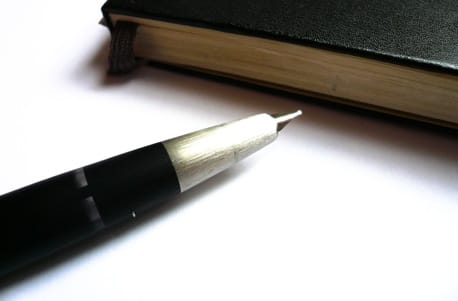
“Verbalizing design is another act of design. I realised this while writing this book,” writes Kenya Hara in the preface to his book, Designing Design. But writing itself is an act of design, whatever the subject.
Over the years I have done quite a bit of writing and recently my PhD is the largest block of words I have ever tackled. I have learned more about design and the creative process through writing than I have through designing.
The Guardian has a piece today titled Writing for a living: a joy or a chore? in which nine authors give their views on writing. There is the usual mix of tortured writers and those that love it and go into a “special place” in their heads, but it’s a good insight into the process because they are all pretty honest. My own feelings about writing are probably closest to Ronan Bennett’s.
I enjoy writing. I like it because it is a slower process than designing on the computer. It takes longer to make something polished because you need to write, edit and re-write several times.
One of the problems with working in applications like Photoshop or Illustrator is that it is easy to produce something glossy, but empty, very quickly. The finished-looking nature of the roughs can be a real handicap to generating new ideas or developing further iterations of an initial one. For this the sketchbook is king.
Tomato’s John Warwacker once said to me that he used to like the days when computers were slow because you could think about what you were doing whilst the progress bar was chugging along. Nowadays, we multitask. A quick Twitter or e-mail whilst Adobe applications crash around and update themselves in the background.
Thinking time is important and the slow, sometimes tortuous, pace of writing is perfect for thinking whilst creating.
Word processors make it easy enough to endlessly tweak, but I prefer keeping things simple with Mellel or Writeroom. Following John Cleese’s advice, writing is one of the few times when I happily ignore everyone. Even Twitter. No, really.
Natalie Goldberg’s advice in Writing Down the Bones
Teaching students has taught me the value of the rough draft too, for students often hold their first idea as sacrosanct. They want to immediately make it, polish it, without realising the first idea is just a stepping stone to the next one and knowing where to stop is the real trick.
I find that much harder with visual design (and I’m not really a graphic designer, but an interaction and experience designer, so I cheat with graphic design). The tools are too distracting, there are too many possibilities and glossy options. I think it is why I prefer working out the concepts and wireframes – the bare bones are almost completely about the experience not the gloss. I’m thinking of downgrading to the earliest version of Adobe apps that will run on my machine. Perhaps I’ll even install Sheepshaver and run Photoshop 1.0 (which I remember using) and PageMaker 1.0.
If you are a designer I can recommend writing as a way to hone your creative process. You can even write about other designers’ writing if you want.
I suspect other people who are sporty have similar stories. Yoga has taught me a lot about slow, steady practice too, as has playing music.
What has been your greatest creative influence outside of your design life?
[Random shout out: Someone called Leigh got in touch with me from my contact page about my PhD. There was a bug in the form that meant I didn’t get the e-mail address. Leigh, can you mail me again - the form is fixed now or you can just use andy at this domain.]

